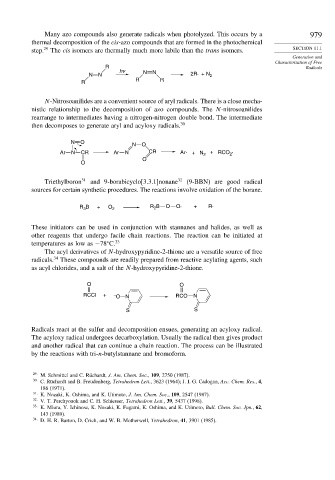Page 995 - Advanced Organic Chemistry Part A - Structure and Mechanisms, 5th ed (2007) - Carey _ Sundberg
P. 995
Many azo compounds also generate radicals when photolyzed. This occurs by a 979
thermal decomposition of the cis-azo compounds that are formed in the photochemical
step. 29 The cis isomers are thermally much more labile than the trans isomers. SECTION 11.1
Generation and
Characterization of Free
R Radicals
hv N N
N N 2R· + N 2
R R
R
N-Nitrosoanilides are a convenient source of aryl radicals. There is a close mecha-
nistic relationship to the decomposition of azo compounds. The N-nitrosoanilides
rearrange to intermediates having a nitrogen-nitrogen double bond. The intermediate
then decomposes to generate aryl and acyloxy radicals. 30
N O
N O
Ar N CR Ar N CR Ar· +N ·
2 + RCO 2
O
O
Triethylboron 31 and 9-borabicyclo[3.3.1]nonane 32 (9-BBN) are good radical
sources for certain synthetic procedures. The reactions involve oxidation of the borane.
R B + O 2 R B O O· + R·
2
3
These initiators can be used in conjunction with stannanes and halides, as well as
other reagents that undergo facile chain reactions. The reaction can be initiated at
temperatures as low as −78 C. 33
The acyl derivatives of N-hydroxypyridine-2-thione are a versatile source of free
34
radicals. These compounds are readily prepared from reactive acylating agents, such
as acyl chlorides, and a salt of the N-hydroxypyridine-2-thione.
O O
RCCl + – O N RCO N
S S
Radicals react at the sulfur and decomposition ensues, generating an acyloxy radical.
The acyloxy radical undergoes decarboxylation. Usually the radical then gives product
and another radical that can continue a chain reaction. The process can be illustrated
by the reactions with tri-n-butylstannane and bromoform.
29
M. Schmittel and C. Rüchardt, J. Am. Chem. Soc., 109, 2750 (1987).
30 C. Rüchardt and B. Freudenberg, Tetrahedron Lett., 3623 (1964); J. I. G. Cadogan, Acc. Chem. Res., 4,
186 (1971).
31 K. Nozaki, K. Oshima, and K. Utimoto, J. Am. Chem. Soc., 109, 2547 (1987).
32
V. T. Perchyonok and C. H. Schiesser, Tetrahedron Lett., 39, 5437 (1998).
33 K. Miura, Y. Ichinose, K. Nozaki, K. Fugami, K. Oshima, and K. Utimoto, Bull. Chem. Soc. Jpn., 62,
143 (1989).
34
D. H. R. Barton, D. Crich, and W. B. Motherwell, Tetrahedron, 41, 3901 (1985).

